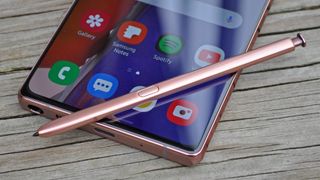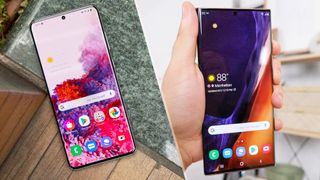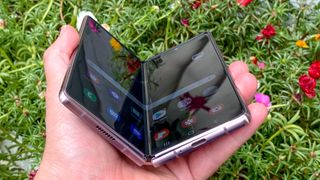It looks like the Galaxy Note is dead — good
Samsung will reportedly combine the Galaxy S and Galaxy Note lines, and that’s the right move

it’s a new smartphone rumor season, in which leaks about next year's big releases fight to fill the void left now that the big fall flagships have made their debut. And one rumor about Samsung's plans seems to be drowning out all others — namely, that the phone maker is ready to pull the plug on its Galaxy Note series, leaving next year's Samsung Galaxy S21 as the one true Samsung flagship.
My reaction to reports that Samsung wants to thin out the top end of its smartphone lineup a little bit? Good riddance.
- Galaxy Note 20 vs. Galaxy S20: Which should you buy
- The best big phones
- Hurry! HP Chromebook just crashed to $149 in killer Black Friday deal
That probably sounds more harsh than I mean it to. After all, I really like the Galaxy Note 20 Ultra — it's easily the best Samsung phone you can buy and it gives the iPhone 12 Pro Max and other Apple models a run for their money. But the fact of the matter is, a lot of phones claim to be Samsung flagship models, and it's getting harder to tell each of the players without a scorecard.
Consider that the arrival of the Galaxy S20 FE this fall now means that there are four Galaxy S20 models to keep straight. Throw in the Galaxy Note 20 Ultra and the slightly less expensive Galaxy Note 20, and that's half-a-dozen top-of-the-line Samsung phones consumers have to compare and contrast. That's great news for people like me who stay employed comparing smartphone specs, but I imagine it makes your shopping decisions more complicated than they need to be.
The end of the Galaxy Note
Rumors making the rounds right now suggest Samsung might be inclined to bring order unto the chaos. Earlier this month, leaker Max Weinbach tweeted the flagship models Samsung plans to release in 2021 — the Galaxy S21, S21 FE, S21 Plus and S21 Ultra, alongside a trio of foldable phones that replace the current Galaxy Z Fold and Galaxy Z Flip models.
Samsung flagships to expect this year:S21 FES21S21+S21 UltraZ Fold 3Z Flip 3Z Fold FENovember 15, 2020
Notice anything missing in that list? Yes, there's no mention of the Galaxy Note 21, with subsequent reports claiming Samsung will end that product line in order to focus its development efforts on foldable devices.
Other reports are adding fuel to this particular rumored fire, with tipster Ice Universe suggesting that there's no information on development of next year's Galaxy Note 21. Another rumor suggests that some Galaxy S21 models — most likely the Galaxy S21 Ultra — would gain support for the S Pen that's been exclusive to the Note thus far. (The S Pen wouldn't ship with the Galaxy S21, mind you; according to this rumor, Samsung would merely add support and sell separate cases that include a slot for the stylus.)
Sign up to get the BEST of Tom’s Guide direct to your inbox.
Upgrade your life with a daily dose of the biggest tech news, lifestyle hacks and our curated analysis. Be the first to know about cutting-edge gadgets and the hottest deals.
Galaxy Note vs. Galaxy S: Is there any difference any more?
If S Pen support does come to the Galaxy S21 when that new phone arrives in the spring, it would be the surest sign yet that the Galaxy Note series has little future. These days, the S Pen and its productivity boosting features is one of the few ways to differentiate the Note from Samsung's Galaxy S phones.

Certainly, screen size is no longer a way to separate the two phone families. Once upon a time, the Galaxy Note was where you turned when you wanted a phablet, a big-screen phone that offered plenty of display estate for getting things done on the go. But now the 6.9-inch Galaxy S20 Ultra has the exact same screen size as the Note 20 Ultra; the 6.7-inch Galaxy S20 Plus and regular Note 20 are the same size, too.
It's just as hard to tell the cameras apart, especially since the S20 Ultra and Note 20 Ultra share a 108-megapixel main lens. In fact, it's hard to shake the sense at every recent Galaxy Note launch that Samsung is merely importing the camera features it introduced to the Galaxy S lineup earlier that year, further cementing the Note's role as an after-thought in Samsung's lineup.
Why the Galaxy Note could stick around
It's worth acknowledging that not everyone shares my view. Ramon Llamas, research director for mobile devices at IDC, told me he has a hard time seeing Samsung merging its two flagship lineups into one. "Galaxy S targets a broad audience, and is most popular among its flagship devices, and works mostly as content consumption," he said. "Galaxy Note appeals to a more productivity-focused user. Think content production."
There has always been overlap [between the Galaxy Note and Galaxy S], but there are benefits to maintaining distinct brands.
— Avi Greengart, Techsponential
Avi Greengart, president and lead analyst at Techsponential, sees a similar breakdown between customers of Samsung's flagships. "There has always been overlap, but there are benefits to maintaining distinct brands – and usage data shows that consumers do make a distinction between them," he said.
Still, it was something that Greengart added that struck me as signs of a potential shift for Samsung. "Where it gets tricky is with Samsung’s Z line of foldables – with its additional real estate and ability to multitask or show more information, the Z Fold 2 has serious productivity chops," Greengart said.
Samsung’s future is foldable
And that's why I think there's a possibility that Samsung merging the best features of the Note lineup into future Galaxy S phones isn't a case of more smoke than fire. If you think of the Galaxy Note as a productivity tool thanks in part to its large screen, how to categorize a phone with an even bigger display that folds into something more compact when you're done working?

Phones like the Galaxy Z Fold 2 and Galaxy Z Flip may draw a niche audience for now, but it seems like Samsung sees their larger screens and multitasking features as a productivity lover's dream. In addition, both phones support Flex mode, which takes advantage of the foldable phone form factor to divvy up the display into viewing and control sections. It's a pretty ingenious way to get work done that simply isn't available on a conventionally designed phone like the Note 20, S Pen or no.
Come this time next year, we'll probably have both a Galaxy S21 and a Galaxy Note 21, plus a lot of different foldable models. "A rich, overlapping lineup makes things harder for Samsung’s brand managers, but it’s a great problem to have," Greengart said.
But the rise of foldable phones gives Samsung a new option to serve both consumer- and productivity-oriented phone shoppers. I hope the company's smart enough to take it.
Philip Michaels is a Managing Editor at Tom's Guide. He's been covering personal technology since 1999 and was in the building when Steve Jobs showed off the iPhone for the first time. He's been evaluating smartphones since that first iPhone debuted in 2007, and he's been following phone carriers and smartphone plans since 2015. He has strong opinions about Apple, the Oakland Athletics, old movies and proper butchery techniques. Follow him at @PhilipMichaels.
-
kin_yalbets I just bought the S10 FE to replace my aging Note 8. Except for the pen, and for all practical purposes, it is an upgrade in experience. The Note line use to be the only way to get a premium experience on Android. For most Note users, and I was one of them, the pen is seldom used. With high end phone features becoming a commodity, a premium price is not required to get a premium experience. I loved my Note 8 but won't be missing it.Reply -
bilavideobill Dream on. You just needed something to talk about and saw your opportunity. Samsung won't drop the Note for two reasons: First, it's a different device, with its own crowd, its own market and a trademark too valuable to squander.Reply
You argue that the Note and the S series have reached a certain parity, making the two devices superfluous. Ah, but the marketplace doesn't run on logic. It runs on sales. The Note and the S series may have the same size screen, with a feature set in common, but you're downplaying their differences.
The Note is flat and rectangular, with curved edges and a stylish pen that adds a world of functionality. It has a flagship distinction that means something in the market. The S series looks more like an iPhone, allowing Samsung to offer its own iPhone alternative with a flat display but a contour that offers another curved brick. It doesn't have to make way for the S pen so it can sink that real estate into something less aimed at productivity and more aimed at the consumer class.
Second - and equally important - staggering Samsung's product release between these two gives Samsung the ability to offer something new every six months rather than place all its bets on a single device offered once a year. It's true: whatever Samsung offers either device today will be on the next device in six months, but that means Samsung can have something new on tap every six months, whereas Apple is committed to its iPhones as a once-a-year product launch.
This isn't the first time some leaker has announced that the Note and the S Series are about to be streamlined, but it never happens. Why it doesn't happen is simple: You can make the S Series as attractive as you like, but you can't afford to miss the opportunity to have the next great thing available in six months rather than a year.
Logic doesn't run the market. Sales do. As long as Samsung benefits from this bifurcated product launch, it will continue to do so. The year it forgets this, it will be quickly reminded that nobody wants last year's technology. They want the new new. -
up11o9 I don't care s and note series merging as one single unit. S pen is a signature feature of note series, I and million others buy it because of it. same featured phone, one with stylus and the other without, could be workable solution.Reply
Most Popular


